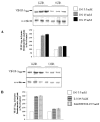Effects of high glucose on vascular endothelial growth factor synthesis and secretion in aortic vascular smooth muscle cells from obese and lean Zucker rats
- PMID: 22949809
- PMCID: PMC3431807
- DOI: 10.3390/ijms13089478
Effects of high glucose on vascular endothelial growth factor synthesis and secretion in aortic vascular smooth muscle cells from obese and lean Zucker rats
Abstract
Type 1 diabetes is characterized by insulin deficiency, type 2 by both insulin deficiency and insulin resistance: in both conditions, hyperglycaemia is accompanied by an increased cardiovascular risk, due to increased atherosclerotic plaque formation/instabilization and impaired collateral vessel formation. An important factor in these phenomena is the Vascular Endothelial Growth Factor (VEGF), a molecule produced also by Vascular Smooth Muscle Cells (VSMC). We aimed at evaluating the role of high glucose on VEGF-A(164) synthesis and secretion in VSMC from lean insulin-sensitive and obese insulin-resistant Zucker rats (LZR and OZR). In cultured aortic VSMC from LZR and OZR incubated for 24 h with d-glucose (5.5, 15 and 25 mM) or with the osmotic controls l-glucose and mannitol, we measured VEGF-A(164) synthesis (western, blotting) and secretion (western blotting and ELISA). We observed that: (i) d-glucose dose-dependently increases VEGF-A(164) synthesis and secretion in VSMC from LZR and OZR (n = 6, ANOVA p = 0.002-0.0001); (ii) all the effects of 15 and 25 mM d-glucose are attenuated in VSMC from OZR vs. LZR (p = 0.0001); (iii) l-glucose and mannitol reproduce the VEGF-A(164) modulation induced by d-glucose in VSMC from both LZR and OZR. Thus, glucose increases via an osmotic mechanism VEGF synthesis and secretion in VSMC, an effect attenuated in the presence of insulin resistance.
Keywords: diabetes; glucose; insulin resistance; lean zucker rats; obese zucker rats; osmotic stress; vascular endothelial growth factor; vascular smooth muscle cells.
Figures




Similar articles
-
Oleic acid increases synthesis and secretion of VEGF in rat vascular smooth muscle cells: role of oxidative stress and impairment in obesity.Int J Mol Sci. 2013 Sep 13;14(9):18861-80. doi: 10.3390/ijms140918861. Int J Mol Sci. 2013. PMID: 24065093 Free PMC article.
-
PCSK9 Expression in Vascular Smooth Muscle Cells: Role of Insulin Resistance and High Glucose.Int J Mol Sci. 2025 Jan 24;26(3):1003. doi: 10.3390/ijms26031003. Int J Mol Sci. 2025. PMID: 39940773 Free PMC article.
-
Nitric oxide activates PI3-K and MAPK signalling pathways in human and rat vascular smooth muscle cells: influence of insulin resistance and oxidative stress.Atherosclerosis. 2011 May;216(1):44-53. doi: 10.1016/j.atherosclerosis.2011.01.019. Epub 2011 Jan 21. Atherosclerosis. 2011. PMID: 21316056
-
Insulin activates hypoxia-inducible factor-1alpha in human and rat vascular smooth muscle cells via phosphatidylinositol-3 kinase and mitogen-activated protein kinase pathways: impairment in insulin resistance owing to defects in insulin signalling.Diabetologia. 2006 May;49(5):1049-63. doi: 10.1007/s00125-006-0156-0. Epub 2006 Feb 28. Diabetologia. 2006. PMID: 16506055
-
Impaired endothelin calcium signaling coupled to endothelin type B receptors in penile arteries from insulin-resistant obese Zucker rats.J Sex Med. 2013 Sep;10(9):2141-53. doi: 10.1111/jsm.12234. Epub 2013 Jul 22. J Sex Med. 2013. PMID: 23875673
Cited by
-
High glucose conditioned neonatal astrocytes results in impaired mitogenic activity in cerebral microvessel endothelial cells in co-culture.Heliyon. 2019 May 23;5(5):e01795. doi: 10.1016/j.heliyon.2019.e01795. eCollection 2019 May. Heliyon. 2019. PMID: 31193586 Free PMC article.
-
Oleic acid increases synthesis and secretion of VEGF in rat vascular smooth muscle cells: role of oxidative stress and impairment in obesity.Int J Mol Sci. 2013 Sep 13;14(9):18861-80. doi: 10.3390/ijms140918861. Int J Mol Sci. 2013. PMID: 24065093 Free PMC article.
-
Molecular Mechanism of Naringenin Against High-Glucose-Induced Vascular Smooth Muscle Cells Proliferation and Migration Based on Network Pharmacology and Transcriptomic Analyses.Front Pharmacol. 2022 Jun 9;13:862709. doi: 10.3389/fphar.2022.862709. eCollection 2022. Front Pharmacol. 2022. PMID: 35754483 Free PMC article.
-
Regulation of constitutive vascular endothelial growth factor secretion in retinal pigment epithelium/choroid organ cultures: p38, nuclear factor κB, and the vascular endothelial growth factor receptor-2/phosphatidylinositol 3 kinase pathway.Mol Vis. 2013;19:281-91. Epub 2013 Jan 3. Mol Vis. 2013. PMID: 23401656 Free PMC article.
-
Astrocytic responses to high glucose impair barrier formation in cerebral microvessel endothelial cells.Am J Physiol Regul Integr Comp Physiol. 2022 Jun 1;322(6):R571-R580. doi: 10.1152/ajpregu.00315.2020. Epub 2022 Apr 12. Am J Physiol Regul Integr Comp Physiol. 2022. PMID: 35412389 Free PMC article.
References
-
- Wirostko B., Wong T.Y., Simò R. Vascular endothelial growth factor and diabetic complications. Progr. Retin. Eye Res. 2008;27:608–621. - PubMed
-
- Ferrara N., Davis-Smith T. The biology of vascular endothelial growth factor. Endocr. Rev. 1997;18:4–25. - PubMed
-
- Carmeliet P. Mechanisms of angiogenesis and arteriogenesis. Nat. Med. 2000;6:389–395. - PubMed
-
- Risau W. Mechanisms of angiogenesis. Nature. 1997;386:671–674. - PubMed
-
- Heil M., Schaper W. Pathophysiology of collateral development. Coron. Artery. Dis. 2004;15:373–378. - PubMed
Publication types
MeSH terms
Substances
LinkOut - more resources
Full Text Sources
Medical

